If you’re feeling like the flood of polarizing news, conflicting economic data, and counterintuitive market reactions has reached a new extreme – you’re not alone.
And if you’re tired of seeing everything labeled “uncertain” – Wall Street’s polite way of saying we don’t know what’s going on – you’re not alone there either.
The problem with calling everything “uncertain” is that it suggests the market is waiting for clarity.
But the market doesn’t wait for clarity.
That’s why most investors “miss out.”
The market moves when it feels confident the picture is clear enough, even if it’s still uncertain.
More often than not, what holds struggling investors back from success isn’t a lack of information, but rather the confusion created by too many signals pulling in too many directions.
Additionally, trying to resolve “uncertainty” is like waiting for Gadot. To be polite – it’s too slow.
Rather than waiting for certainty, look to clarify the confusion.
There’s a well-known saying in marketing:
“A confused mind doesn’t buy.”
The same holds true for investors, and this leads to the dreaded emotion of FOMO (fear of missing out), which tends to produce poor decisions.
The solution to FOMO isn’t eliminating uncertainty but rather clarifying the confusion.
Easier said than done, but investing is hard.
Good trades and investments begin with clarity, and become great with conviction and risk management that allows trends to mature.
As last week’s Market Outlook article demonstrated, investing becomes even harder—and more frustrating—when you let the market’s mirages cloud your judgment.
AI might help with that someday—assuming it stops hallucinating and becomes a little less artificially intelligent.
Until then, the job still falls to us humans—with a little help from your favorite AI assistant.
This week, let’s look at several of last week’s notable events that the media and analysts described as increasing uncertainty, and differentiate “uncertainty” from “confusion.”
Think of uncertainty as:
“I don’t know what will happen, but I know what I’m watching.”
Think of confusion as:
“I’m not sure what matters right now—or why the market is reacting this way.”
More Than A Trade War
Let’s start with Trump’s new 50% tariff on copper!
is a critical ingredient in building out everything that uses and delivers power. The administration is pushing the rapid buildout of data centers. Why make it more expensive?
One reason is that he believes it will lead to bringing more copper production to the US.
However, the chart below shows a much more obvious reason for this big announcement, and it suggests the copper industry is likely to be in focus for the duration of Trump’s administration because the tariff is not about fair trade.
The most popular chart related to the tariff imports (other than the commodities price chart) is likely one similar to the one below, which shows Chile and Canada as the largest source of copper imports.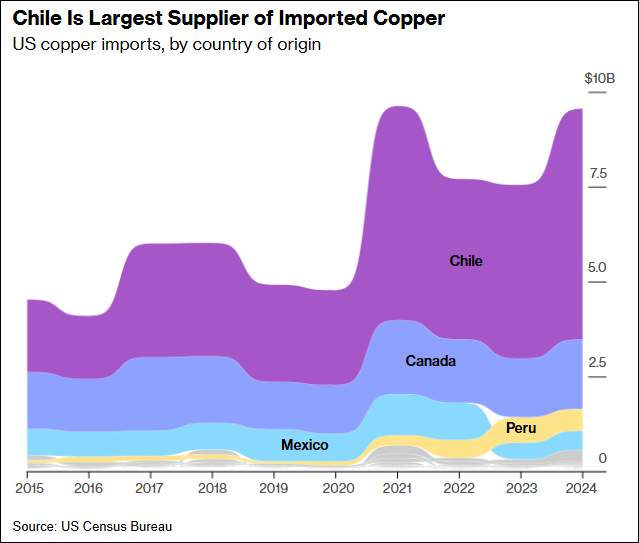
As you can see from the chart below, Chile is the global leader in copper mining production. However, what is not apparent from this chart is the fact that China controls about 80% of the mining of copper and cobalt in the Congo (DRC).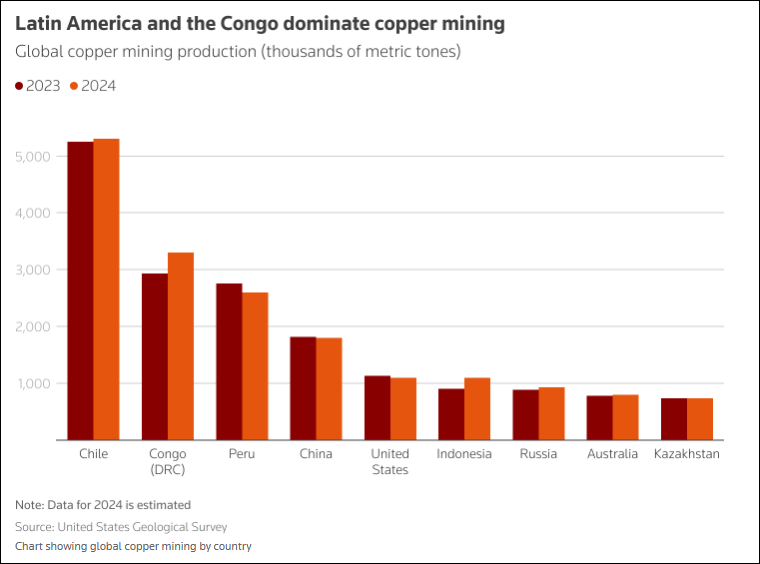
The rough math of adding China’s production and Congo’s production will show that China is effectively the world’s co-leader in copper production.
That’s just mining it from the ground. Next, the metal needs to be refined.
As you can see from the chart below, China is responsible for over 50% of the global refining or smelting of copper. The US only has two smelting plants which account for only 3% of the global output. It’s typically an expensive, dirty, unpopular process that is not very profitable.
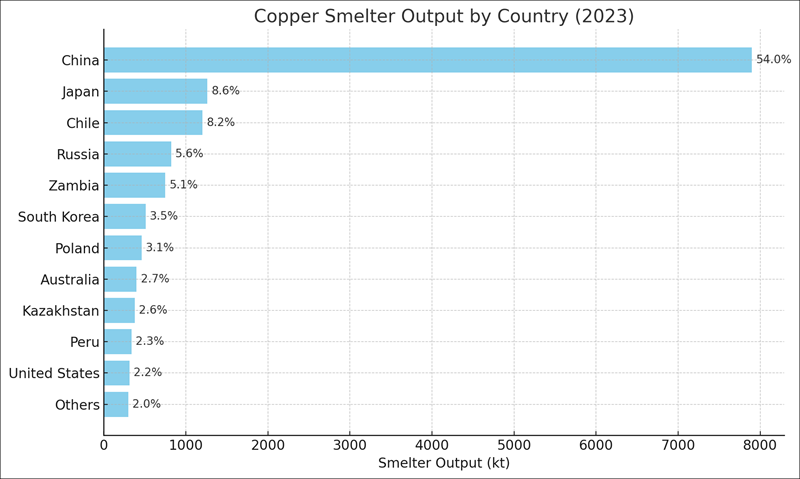
In case it’s not obvious, copper is an integral ingredient in everything from homes and transportation to aviation and microchips.
So the copper tariff isn’t about fair trade, it’s related to national security and improving our leverage relative to China.
We may “hold a lot of the cards” when it comes to the most sophisticated AI processors that China envies, but we don’t hold all the cards with respect to the metals required to build them.
More Mania In The Metals!
Copper wasn’t the only metal in the spotlight last week.
As you can see from the chart below, broke out of a multi-week consolidation to reach a 13-year high.
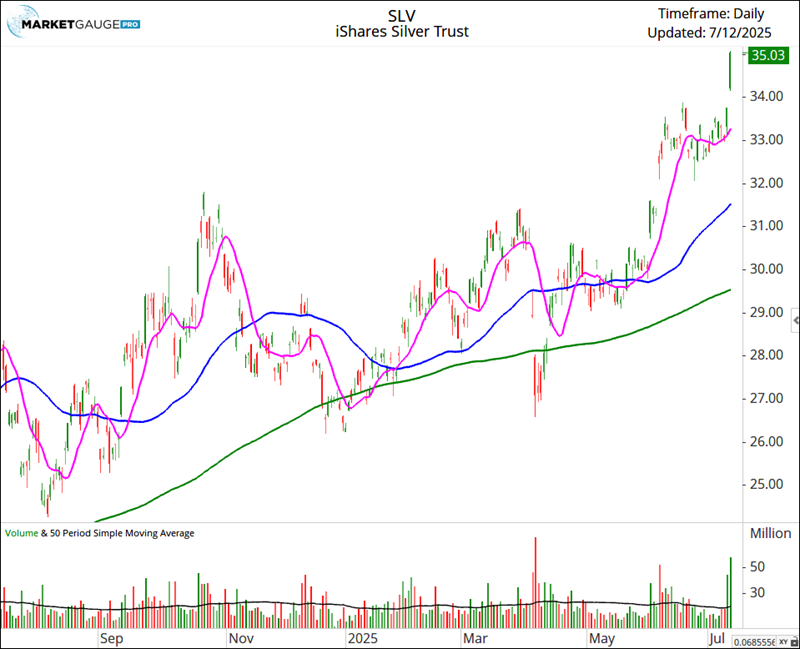
You may recall the chart below from our , in which we highlighted silver’s pattern of following in the footsteps of gold.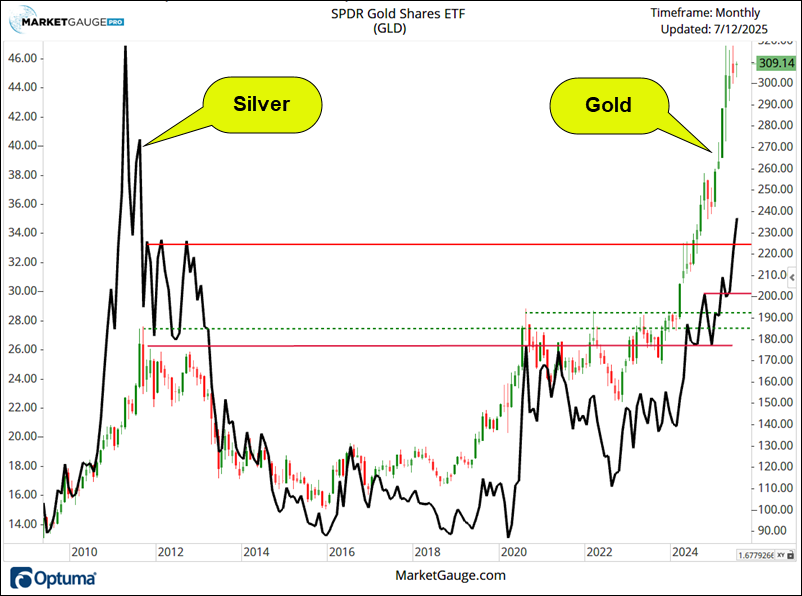
In 2020, matched its 2012 high. Silver peaked in 2012 along with gold, but it has yet to get back to that high. If it’s on its way there, that’s equivalent to $46 or about 31% higher.
, however, has risen about 60% over its 2012 and 2020 highs, and if silver were to match that pattern, it will be trading over 100% higher than its current levels.
has long been looked at as the speculative cousin of gold by commodity traders, and Mish has pointed out for a long time that it’s overdue for a “catch up” bull market. If you’re following Mish, the last 50%+ move should not be a surprise to you.
Silver’s breakout of its 2020 high, which coincided with gold’s 2020 high, was about 9 months behind gold. In early 2024, when gold broke out, it had its share of idiosyncratic tailwinds like central bank buying, increasing fear of higher along with slowing economic growth, and an upcoming election that was raising concerns of political instability.
After the election gold’s trend accelerated as it became increasingly viewed as a safe haven currency.
Is silver about to have its accelerating idiosyncratic moment?
It’s not surprising that silver would respond to the copper tariffs with a big move.
Unlike gold, silver derives some of its demand from the fact that it is an industrial metal.
In fact, copper doesn’t have many good substitutes because the second-best electrical conductor is silver, which is much too expensive to replace copper!
Silver’s rally isn’t just tied to gold or copper.
Most people probably don’t realize we’re in the midst of an incredible bull market in metals and minerals!
As you can see in the chart below, 2025 has seen some big moves in metals:
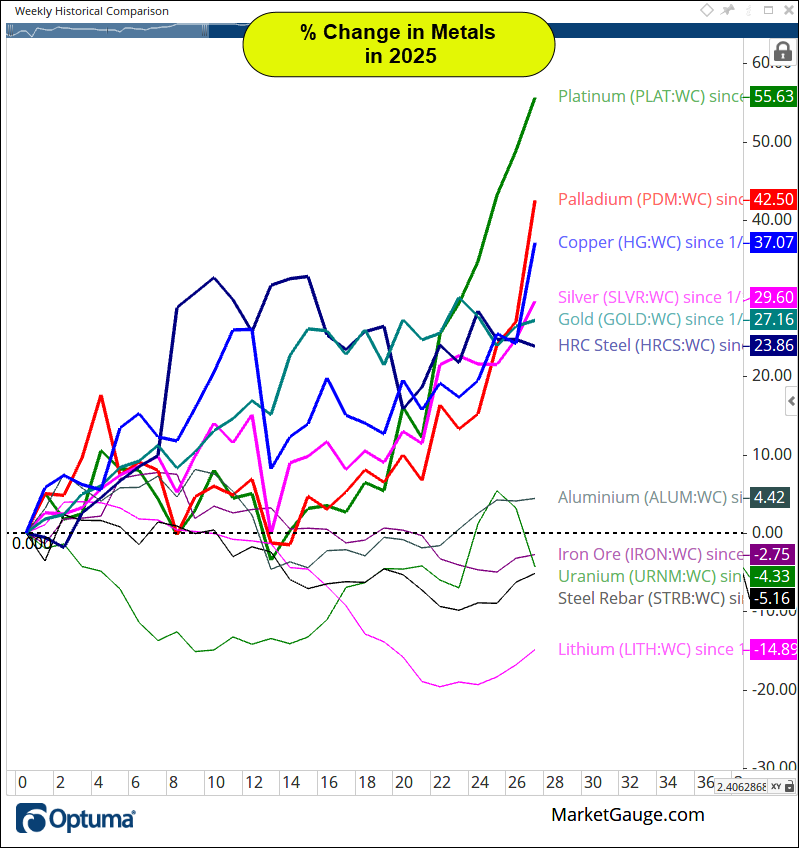
As you can see, the moves in silver and copper aren’t even the biggest movers this year. and have outpaced them by a wide margin.
There are a lot of factors that will drive all these metals individually and as a group. Each of the factors is filled with uncertainties, not the least of which is the administration’s tariff campaign.
What’s clear, however, is that behind the chaos of policy announcements and tariff negotiations, countries and companies are adapting to new rules and costs that impact their supply chains. Let them focus on all the uncertainty. As an investor, you can simply focus on how the markets, countries, and companies adapt, succeed, or fail.
For commodities, focus on the price action, not the political rhetoric or analysts’ lists of uncertainties.
For companies, focus on the stock’s price trend, how it moves relative to the market, and (optionally) whether or not the moves are in alignment with management’s guidance.
Last Week, Tariff Uncertainty Spiked and Stocks Rallied
Last week, Trump raised the level of tariff uncertainty to its highest level in weeks, and stocks rallied as if they didn’t care.
The market does care, but it has learned that companies and countries can adapt, and it’s prudent to avoid confusing policy with reality.
Is The Dollar Going to Cause Stocks to Melt UP or
Is It Losing Its Reserve Currency Status?
It seems that the ’s recent bear market has been equated to the idea of the dollar losing its status as the reserve currency. If that were to really happen, there would be a lot of ‘uncertainty’ and good reasons for equity investors to be anxious about the repercussions.
Rather than debate the fate of the dollar in the eyes of the rest of the world, take a look at the long-term trend in the chart below.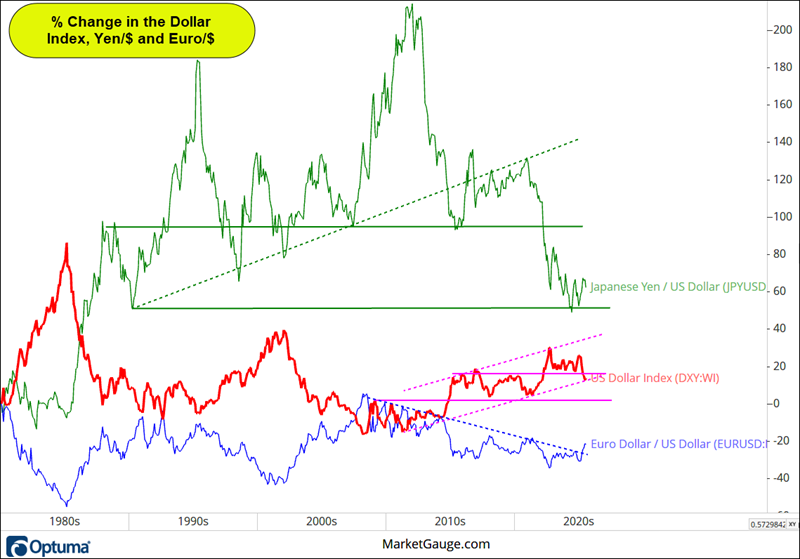
The red line is the , and as the magenta trend lines and horizontal level illustrate, the trend over the last 15 years is still up. The recent decline has brought it back to the middle of a stable range it has held since its bottom in 2008.
With respect to the , the dollar is as strong as it’s been since 1990.
While the looks like it’s set up to gain on the dollar, it’s far from a crisis of confidence in the dollar.
Considering the fact that nearly 50% of the revenues of the companies are earned abroad, the recent decline in the dollar may actually be bullish for stocks as it will help boost company earnings right when the market seems to be full of animal spirits capable of a melt up in stocks.
The CPI Report This Week Won’t Matter
Normally, I’d be saying what many other analysts are saying about being prepared for this week, which is that the data due out this week could set the tone for the direction of the market.
However, all the uncertainty around the data and how it might impact the Fed’s decision to is a good example of when to focus on what’s confusing the market.
Powell has been very clear that he sees the tariff uncertainty being an almost certain source of some form of inflation. Furthermore, he’s strongly implied that in an environment where the economy is strong, he’s not going to cut rates until he has hard data on the inflationary impact from the tariff policy.
With the increase in tariff rhetoric recently, one month of CPI data won’t move the Fed or drive the market for more than a day or two.
Be careful not to let the CPI reporting confuse what the market cares about most this week.
What Will Move The Market?
Earnings season has the greatest chance of setting the tone that will drive the market for the next several months.
Everything this article has discussed will be reflected in the earnings and guidance that will be released over the next month.
At the beginning of this article, I suggested…
Think of confusion as:
“I’m not sure what matters right now—or why the market is reacting this way.”
Since then, I’ve suggested that what matters is NOT what the news is saying, but instead what companies are reporting they’ve achieved with earnings, sales, and margins, and what their guidance is going forward.
Are companies’ prospects getting better or worse?
Is the market rewarding companies for good news or selling into it?
If you listen to the market’s reaction to earnings season objectively, you can find the market less confusing and uncertainty less concerning.
Summary: Despite a modest pullback in equities, risk-on conditions remain mostly intact with crypto and semiconductors hitting new highs, volatility declining, and growth continuing to outperform value. However, underlying market internals have weakened to neutral, with mixed volume patterns, sector performance, and growing strength in commodities like gold and oil signaling potential headwinds.
Risk On
- Markets were down marginally this week between -0.36% and -1.33%, after digesting monster gains since the April lows. We want to see the market hold the lows of this week to maintain its strong bullish trend. (+)
- Risk gauge remains in full-risk on mode, though increased strength in gold could flip some of the ratios negative. (+)
- Short-term volatility continued to drop on the week. (+)
- The modern family held up well relative to the benchmark. We closed at new all-time highs in semiconductors without being overbought and saw some improvement in and . (+)
- Growth continues to lead value on short and long term reading. (+)
- and crypto broke out to new all-time highs. It is generally seen as a risk-on move as speculative money loves crypto. (+)
- July is one of the strongest seasonal months of the year. (+)
Neutral
- Volume patterns backed off from mostly risk-on last week to neutral readings. With the showing the weakest reading of the four key indexes.(=)
- 9 sectors that we track were down on the week and 9 were up on the week. were down while semiconductors were up. (=)
- Up/down volume retreated from overbought levels to slightly negative. The McClellan Oscillator backed off from overbought to slightly positive but looking a little heavy. (=)
- The new high new low ratio flipped negative on a short-term basis from overbought levels, however, intermediate trends remain positive. (=)
- On a short to intermediate term basis, the color charts (moving average of stocks above key moving averages) have flip to neutral at best, however, on the 200-day periods, the trend remains intact. (=)
- Large-cap foreign equities have given up its leadership against the S&P and really need to hold its 50-Day Moving Average to remain in a bullish phase. If it does break, it could be a leading indicator of a potential global sell-off in equities. (=)
- Copper exploded to the upside based on geopolitical events, AI demand, and tariffs. (=)
- Despite the fact that on the longer-end of the yield curve moved back into a bear phase/higher rates. It remains unclear what the Fed will do next in the upcoming July meeting. (=)
Risk Off
- Commodity prices, led by metals and were the biggest 5-day leaders regarding all asset classes. (-)
- The S&P hit major resistance against gold on a longer-term basis and could indicate further issues for the market.(-)
- Gold resumed its bullish trend and oi lis be trending higher as well. (-)
คำแนะนำการอ่านบทความนี้ : บางบทความในเว็บไซต์ ใช้ระบบแปลภาษาอัตโนมัติ คำศัพท์เฉพาะบางคำอาจจะทำให้ไม่เข้าใจ สามารถเปลี่ยนภาษาเว็บไซต์เป็นภาษาอังกฤษ หรือปรับเปลี่ยนภาษาในการใช้งานเว็บไซต์ได้ตามที่ถนัด บทความของเรารองรับการใช้งานได้หลากหลายภาษา หากใช้ระบบแปลภาษาที่เว็บไซต์ยังไม่เข้าใจ สามารถศึกษาเพิ่มเติมโดยคลิกลิ้งค์ที่มาของบทความนี้ตามลิ้งค์ที่อยู่ด้านล่างนี้
Source link








